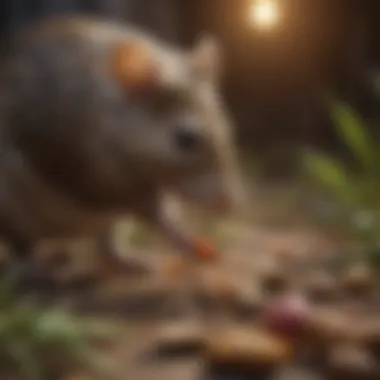Fast-Acting Rodenticides: Composition and Safety Insights


Intro
In the realm of pest control, understanding the fastest mouse poison is essential for both effectiveness and safety. This article delves into the realm of fast-acting rodenticides, exploring their composition, efficacy, and implications for humans and animals. With a focus on the science behind their rapid lethality, we seek to provide a thorough guide for veterinarians, wildlife biologists, and families grappling with rodent infestations. It is vital to emphasize the importance of responsible use and awareness of potential hazards.
Animal Overview
Common Name and Scientific Classification
The common name for the rodent typically targeted by mouse poison is the house mouse, scientifically classified as Mus musculus. This species is one of the most prevalent pests across urban areas worldwide. Understanding its classification aids in discerning the appropriate control methods.
Physical Characteristics
House mice are small, agile creatures with a body length ranging from 3 to 4 inches, excluding the tail. Their fur is typically gray or light brown, with a lighter underside. Their ears are large relative to their body size, and their tails are long and sparsely furred, making them adept in navigating various environments. These physical features help them survive in diverse habitats.
Habitat and Distribution
House mice are extremely adaptable and can thrive in urban, suburban, and rural settings. They often establish nests in hidden locations like basements, attics, or behind appliances. Their ability to reproduce quickly makes them prevalent in areas where food and shelter are available. They can be found across all continents, with their populations concentrated around human habitation.
Behavior and Social Structure
Communication Methods
Mice communicate through various means including vocalizations, pheromones, and body language. They use high-pitched squeaks to convey distress or location, while scent marking serves to establish territory.
Social Hierarchies
House mice are generally social animals that exhibit a fluid social structure. Dominance hierarchies may emerge in their colonies, influenced by factors like age, size, and agility. These dynamics affect their breeding opportunities and overall interactions.
Mating and Reproductive Behavior
Mating occurs throughout the year, although peak reproductive activity typically coincides with warmer months. Females can breed as early as six weeks old and may have multiple litters, each comprising 5 to 10 pups. This rapid reproduction contributes significantly to their survival and persistence as a common pest.
Conservation Status
Current Population Trends
The house mouse is not considered threatened. In fact, its population remains robust due to its adaptability and close association with humans. However, this same adaptability often leads to significant ecological impacts in regions where they are invasive.
Threats and Challenges
While house mice face predation from natural predators like cats and birds of prey, human intervention through poison and traps poses a major challenge. The use of fast-acting rodenticides creates additional risks to non-target wildlife and pets.
Conservation Efforts and Success Stories
Efforts to balance pest control with environmental safety are underway. Integrated pest management strategies are being adopted to minimize reliance on chemicals. These approaches combine physical barriers, exclusion methods, and careful monitoring, thereby ensuring a safer coexistence with wildlife while effectively managing rodent populations.
A key aspect of pest control is understanding the ecological balance and ensuring that methods employed do not cause unintended harm.
By taking an informed perspective, both families and pest control professionals can navigate the complexities of using mouse poisons responsibly while comprehensively addressing the issue of rodent infestations.
Understanding Rodenticides
Rodenticides are critical tools in managing rodent populations, both in urban and rural settings. The understanding of these substances, their classifications, and how they function is vital for effective pest control. Without this knowledge, users may inadvertently cause harm to non-target species or even endanger human health. In this article, we will explore the various types of rodenticides, their mechanisms of action, and the underlying principles that make them effective against unwanted rodent infestations.
Definition and Purpose
Rodenticides are chemicals specifically designed to kill rodents. Their primary purpose is to reduce or eliminate pest populations that can cause damage to property and spread diseases. Understanding the definition of rodenticides helps to establish clarity about their intended use. Targeting species like mice and rats, these substances serve an important role in public health and agricultural practices. Proper knowledge about rodenticides allows users to implement responsible and effective pest management strategies, ensuring minimal impact on the ecosystem.


Types of Rodenticides
When discussing rodenticides, it is essential to differentiate among the various types available. Each group possesses its own characteristics that determine its effectiveness and suitability for different situations. Broadly, rodenticides can be classified into three categories: anticoagulant rodenticides, non-anticoagulant rodenticides, and natural rodenticides.
Anticoagulant Rodenticides
Anticoagulant rodenticides inhibit the blood's ability to clot, leading to eventual death from internal bleeding. This type is widely recognized and popular due to its effectiveness over multiple feedings, which can prolong the bait's effectiveness. Anticoagulants work by disrupting the vitamin K cycle in the body. However, an important characteristic of these substances is that they may take several days to show full lethality. This can be advantageous in reducing bait shyness in rodents, but it also poses some risks. One risk is that non-target species may have time to consume the bait as well. Therefore, while anticoagulant rodenticides are effective, they also require careful placement to prevent accidental exposure.
Non-Anticoagulant Rodenticides
Non-anticoagulant rodenticides act through different mechanisms, such as causing dehydration, paralysis, or metabolic disruption. These substances often achieve faster results than their anticoagulant counterparts. A notable aspect of non-anticoagulant rodenticides is that they generally require only one feeding. However, this rapid onset can mean that they must be used with even greater caution. Many of these rodenticides can have severe effects on beneficial wildlife, so understanding their specific impacts is crucial for responsible use.
Natural Rodenticides
Natural rodenticides are derived from natural sources and often utilize ingredients considered less harmful to the environment. Their appeal lies in the perception that they minimize chemical exposure for both humans and animals. A key characteristic of these substances is that they can provide a more humane approach to pest control. However, their effectiveness may vary widely, and they often require more frequent applications compared to synthetic alternatives. While natural options can be beneficial, they may not always deliver the rapid results that some users seek, which must be weighed against environmental and health considerations.
Understanding these types of rodenticides lays a solid foundation for making informed decisions regarding pest management. The choice of rodenticide should be based on a thorough assessment of the situation, including the urgency of the problem and the potential risks involved.
Mechanism of Action
The mechanism of action section is vital in understanding how fast-acting mouse poisons operate. The effectiveness of these rodenticides hinges on their chemical composition and the biological processes they disrupt. Comprehending this mechanism helps users make informed decisions about using these poisons safely and effectively.
How Mouse Poison Works
Mouse poisons, specifically rodenticides, are designed to target the physiological systems of rodents. They typically disrupt critical biological functions which ultimately leads to the death of the animal.
- Anticoagulant Rodenticides: These poisons interfere with the rodent's ability to properly clot blood. They cause internal bleeding, which can go unnoticed until it is too late.
- Non-Anticoagulant Rodenticides: These act in different ways. Some disrupt the central nervous system, causing paralysis and eventual death. Others may damage vital organs directly.
- Natural Rodenticides: These types rely on naturally occurring compounds that can be lethal to mice. They often take longer to act but may have fewer side effects on non-target species.
The poison is ingested by the rodent, and the effects can vary based on the formulation. Knowing the specific action helps users recognize the signs of poisoning and implement necessary precautions.
Rapid Onset of Action
The term 'rapid onset of action' refers to how quickly a rodent gets affected after consuming the poison. This characteristic is crucial for effective pest control. Fast-acting poisons reduce the window during which the rodent can escape or reproduce, minimizing potential damage or contamination in a home or facility.
- Immediate Effectiveness: Many formulations are designed to produce symptoms within hours of ingestion. This includes loss of coordination and lethargy.
- Easier Monitoring: With a rapid response, affected rodents are easier to locate, allowing for timely removal.
- Reduced Exposure Risk: Fast-acting poisons, when used correctly, can significantly reduce prolonged exposure risks to non-target animals and humans.
Choosing Fast-Acting Mouse Poison
Choosing fast-acting mouse poison is crucial for effective pest control. When dealing with rodent infestations, time is often of the essence. Fast-acting formulations help to quickly reduce rodent populations, preventing further damage and contamination. However, selecting the right mouse poison requires careful consideration of several factors to ensure safety and effectiveness.
Factors to Consider
Effectiveness
Effectiveness is a primary concern when selecting a mouse poison. It indicates how quickly a particular formulation can eliminate rodents. Fast-acting rodenticides offer rapid results, which is often a beneficial feature, especially in severe infestations. For instance, some anticoagulant poisons may take several days to show results, while acute poisons can kill within hours after ingestion. It is essential to evaluate the active ingredients and their lethality profile. However, high effectiveness should balance with safety considerations.
Application Method
The application method is another critical aspect to consider. Different mouse poisons have various methods of application, such as bait stations, liquid solutions, or powders. Using bait stations can offer a discrete and controlled method of applying the poison. It can also reduce accidental exposure to non-target species. Liquid solutions may offer rapid action but can be less practical in certain environments. Each method has its advantages and disadvantages in terms of usability and safety, making it essential to choose one that fits the specific situation.
Target Species
Understanding the target species is vital for choosing the right mouse poison. Not all products are equally effective against different rodent species. For example, house mice may respond well to certain formulations, while Norway rats may require a different approach. Choosing a rodenticide that targets the specific species in question ensures better results and reduces the risk of harming non-target animals. Therefore, identification of the pest is necessary before selecting a mouse poison.
Top Fast-Acting Formulations
When it comes to fast-acting mouse poisons, several formulations stand out due to their efficiency and usage. Some of the most effective products include rodenticides containing bromethalin or brodifacoum, which are known for their rapid action.


Each fast-acting formulation comes with its guidelines and safety precautions. Following those instructions is important to maximize effectiveness while minimizing risks.
Popular brands, such as D-Con and Motomco, provide a range of rodenticides that cater to various needs. These products often emphasize safety, effectiveness, and ease of use.
By carefully considering effectiveness, application method, and target species, users can make informed decisions when choosing fast-acting mouse poison. Always remember to follow safety measures during application to mitigate any potential hazards.
Risks and Safety Concerns
The discourse on fast-acting mouse poisons is incomplete without addressing the associated risks and safety concerns. Understanding these elements is crucial for responsible usage, especially in environments where non-target species, humans, and pets are present. Evaluating these risks informs better decision-making and promotes safer practices in pest control.
Impact on Non-Target Species
Mouse poisons, while effective for controlling rodent populations, carry significant risks to non-target species. This includes birds, wildlife, and any other animals that might come into contact with poisoned rodents or the poison itself. Secondary poisoning can occur when predators or scavengers consume affected rodents.
- Predator Risks: For example, owls and hawks are often at risk. Their diet includes rodents, so when they consume a poisoned mouse, they inadvertently ingest the toxin. Even if the primary target was a mouse, the implications can extend up the food chain.
- Ecological Balance: The disruption of local ecosystems is another concern. Decreased populations of predators can result in overpopulation of certain species, leading to further imbalances.
Precautions should be taken to monitor wildlife populations and adjust the use of these poisons accordingly. Using baits in enclosed areas can minimize exposure to non-target animals.
Health Risks for Humans and Pets
Health risks posed to humans and pets must be a primary consideration when using chemical rodenticides. Several fast-acting poisons can be harmful or even fatal if ingested or improperly handled. It is essential to recognize potential dangers and implement safe practices.
- Pet Safety: Dogs and cats are particularly vulnerable. Their curious nature may lead them to sniff or consume the bait. Symptoms of poisoning in pets can include vomiting, lethargy, or bleeding. Thus, it is advisable to keep pets away from treated areas and to use tamper-proof bait stations.
- Human Exposure: For humans, accidental exposure can occur through skin contact or inhalation of dust from the poison. Additionally, young children are especially at risk. It is critical to read label instructions carefully and follow all precautions to mitigate these risks.
Being aware of these dangers allows for better precautionary measures to protect both household members and pets.
Environmental Considerations
Fast-acting mouse poisons present various environmental concerns that deserve scrutiny. The broader ecological footprint of rodenticides can impact water supplies, soil health, and surrounding wildlife.
- Contaminant Leakage: If not properly disposed of, leftover poisons can contaminate soil and waterways. This can lead to long-term ecological consequences due to the persistence of certain chemicals in the environment.
- Biological Degradation: Many rodenticides vary in their biodegradability. Some may introduce toxins that can accumulate in the food chain, affecting plants and animals over time.
To minimize environmental impact, practitioners should prioritize the use of less harmful alternatives when possible and ensure precise application methods to lower the risk to surrounding ecosystems. Additionally, monitoring the effects on local wildlife populations may help in understanding and mitigating negative impacts.
In summary, it’s crucial to balance effective rodent control with awareness of the potential risks. By prioritizing safety and responsible use practices, individuals can contribute to better protection of humans, pets, and the environment.
Effective Application Techniques
Effective application techniques are critical for maximizing the efficacy of fast-acting mouse poisons. Understanding these methods can ensure that these substances work as intended while minimizing risks to non-target species and the environment. Careful application can lead to an improved outcome in pest control efforts, which is significant for veterinarians, wildlife biologists, and families involved with rodent control. This section explores key elements in the application of mouse poisons, including proper placement, dosage and frequency, and aftercare and monitoring.
Proper Placement
Placement of mouse poison is crucial. Setting the bait in the right locations can lead to faster results. Rodents tend to travel along walls, behind appliances, and in hidden corners. By positioning the poison in these high-traffic areas, the likelihood of rapid ingestion increases.
Key considerations for placement include:
- Avoiding areas accessible to children and pets.
- Ensuring that the bait is out of sight, but still reachable to rodents.
- Using bait stations to secure the poison and prevent spills.
In addition, consider the behavior of different rodent species. Mice are often attracted to sites where food is available. Thus, placing poison near sources of food can enhance effectiveness. Moreover, regularly changing positions can keep rodents uncertain and more likely to encounter the poison.
Dosage and Frequency
Correct dosage and frequency are essential for effective treatment. Fast-acting mouse poisons come with specific guidelines regarding how much to use. It is important to adhere to these recommendations to avoid under-dosing, which may result in ineffective control, or overdosing, which can pose safety risks.
Factors influencing dosage and frequency include:
- The type of poison used.
- The size of the infestation. A larger amount may be needed for significant populations.
- The specific behavior of the rodent species targeted.


Follow the directions on the packaging closely. As a general rule, frequent monitoring of the bait stations and replacing them within the recommended timeframe can drastically improve outcomes. Understanding the life cycle and eating habits of the target species helps refine the frequency of applications needed.
Aftercare and Monitoring
Post-application care is often overlooked, yet it is critical for ensuring safety and efficacy. After placing mouse poison, monitoring the site regularly is crucial. This step will help to ensure that the bait remains effective, and there are no risks to non-target animals or humans.
Monitoring should include:
- Checking bait stations to see if they have been consumed.
- Disposing of any remains safely, especially if a rodent has died in a hidden location.
- Observing signs of activity or new infestations in the area, which can necessitate further treatment.
Remember that the safety of the environment, including pets and children, should always be a priority. Establishing a routine check-up of the area can prevent unwanted consequences from using mouse poisons.
Alternatives to Fast Mouse Poisons
Exploring alternatives to fast mouse poisons is crucial for effective pest management. These methods provide a range of benefits, from safety to sustainability, appealing especially to families and professionals who have ethical concerns about chemical usage. Addressing rodent problems does not solely hinge on speed of extermination; it also involves the health of children, pets, and the environment.
Non-Toxic Methods
Non-toxic methods serve as viable alternatives to traditional rodenticides. They promote safety while being effective. Some examples include:
- Essential Oils: These can repel mice due to their strong scents. Cinnamon and peppermint oils are popular choices.
- Homemade Repellents: Often made from items already in the home, such as vinegar and water solution, these are both natural and safe.
- Electronic Repellents: These devices emit a sound unattractive to rodents, encouraging them to leave the area.
The effectiveness of these methods can vary. However, many find that not using poisons leads to peace of mind.
Traps and Mechanical Solutions
Mechanical traps provide an immediate response without the risks associated with poisons. These traps are available in various designs:
- Snap Traps: Quick and efficient, these traps kill mice instantly. Proper placement is important for success.
- Glue Traps: While they do not kill instantly, they capture mice to be dealt with later.
- Catch-and-Release Traps: These allow humane capture where the mice can be relocated. However, they require more engagement from the user.
Using traps means constant monitoring, but they can lead to a more controlled environment. It's essential to research each type thoroughly for effectiveness.
Exclusion and Prevention Techniques
Preventing mice from entering a space is often more effective than removing them after they gain access. Implementing exclusion techniques can make a significant impact. Key methods include:
- Sealing Entry Points: Determining where mice get in is essential. All holes and gaps should be sealed with materials like steel wool or caulking.
- Cleaning and Decluttering: Keeping areas tidy removes attractants. Food should be stored securely, and waste must be disposed of promptly.
- Landscape Management: Keeping shrubs and trees trimmed reduces hiding places. Maintaining a clean yard is important for overall pest control.
These measures require ongoing effort, but they lead to long-term success. The time invested in exclusion techniques pays off in reduced infestations and healthier living environments.
Alternatives to fast mouse poisons not only eliminate safety concerns but also promote a more holistic approach to pest management.
Adopting these methods, while maintaining vigilance, ensures that rodent issues can be managed effectively without the harmful implications of fast-acting poisons. Families can feel secure, and professionals can rely on sustainable practices.
Closure
The topic of using fast-acting mouse poison is multifaceted and crucial to understand for anyone involved in pest control or concerned about rodent infestations. The key aspects covered in this article provide a roadmap for responsible usage. Understanding the types and mechanisms of rodenticides is foundational for effective application.
Summarizing Key Points
In summary, this analysis has highlighted several important elements regarding fast mouse poisons:
- Types of Rodenticides: Differentiating between anticoagulant, non-anticoagulant, and natural options enables targeted decisions based on specific scenarios.
- Mechanism of Action: Knowing how these substances rapidly affect rodents is vital for anticipating behavior and outcomes during application.
- Risks and Safety Concerns: It is essential to consider the potential impact on non-target species, humans, and pets. Safety protocols must be non-negotiable to ensure responsible use.
- Effective Application Techniques: Proper placement, dosage, and aftercare significantly influence the success and safety of rodent control efforts.
- Alternatives: While fast-acting poisons can be effective, understanding non-toxic options, traps, and preventive strategies is equally crucial. This broader perspective can lead to long-term solutions and healthier ecosystems.
Final Considerations
Fast mouse poisons serve a purpose but come with responsibilities. Careful evaluation of situations where their use is necessary is fundamental. Families, veterinarians, and wildlife biologists must prioritize safety for all living beings.
The discussion does not end with choosing a product; it's about ongoing education and adaptation to new insights regarding rodent control. As we continue to learn about the ecological implications of rodenticides, the emphasis should shift towards comprehensive strategies that honor both pest management goals and the welfare of the environment.
"Understanding the balance between effective pest control and ecological responsibility is key to sustainable practices."
Embracing this mindset will guide users toward informed decisions and ultimately foster safer and healthier living environments.







